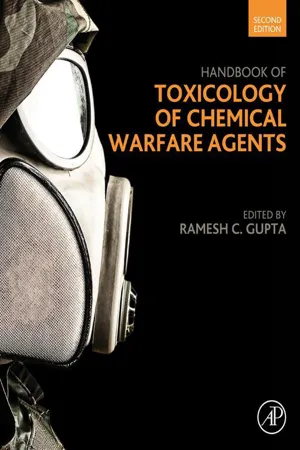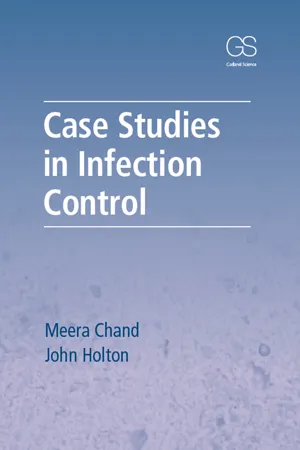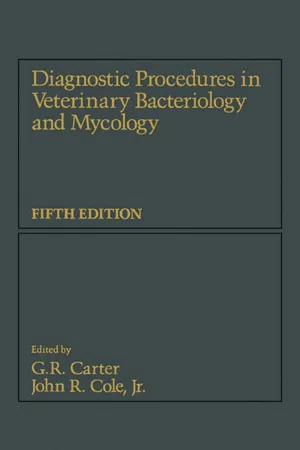Biological Sciences
Anthrax
Anthrax is a serious infectious disease caused by the bacterium Bacillus anthracis. It can affect humans and animals and is known for its potential use as a biological weapon. Anthrax can be transmitted through contact with infected animals or their products, inhalation of spores, or ingestion of contaminated meat. Symptoms can vary depending on the route of exposure and can be severe if not treated promptly.
Written by Perlego with AI-assistance
4 Key excerpts on "Anthrax"
Learn about this page
Index pages curate the most relevant extracts from our library of academic textbooks. They’ve been created using an in-house natural language model (NLM), each adding context and meaning to key research topics.
- Ramesh C Gupta(Author)
- 2015(Publication Date)
- Academic Press(Publisher)
Chapter 29Anthrax
Corey J. Hilmas and Jaime AndersonThe fear of Bacillus anthracis has been heightened in recent years as a result of the terrorist events in 2001 and the increase in acts of terrorism worldwide. There are few infectious agents that are more notorious than B. anthracis . B. anthracis would be an ideal weapon for a terror attack because of its potent and lethal nature in the course of causing Anthrax disease. Once inside the host, the organism can proliferate and spread rapidly, resulting in systemic infection and release of soluble toxin factors; Anthrax produces a high mortality rate if left undiagnosed and untreated. To complicate matters, the bacillus responsible for Anthrax infection can survive long-term outside of its host as a dormant spore. Additionally, host animals and humans infected by the bacterium and its Anthrax toxins can display general symptoms characteristic of numerous infections or disease states, prolonging the time required for immediate diagnosis to initiate early treatment. This chapter provides a structured and comprehensive insight into the history, pathogenesis, toxicity, toxicokinetics, mechanisms of action, risk assessment, and treatment of Anthrax.Opinions, interpretations, conclusions, and recommendations are those of the authors and are not necessarily endorsed by the US Army or the US Food and Drug Administration.Keywords
Anthrax; Bacillus anthracis ; Lethal toxin and Edema toxin; toxicity; protective antigen; Cutaneous Anthrax; Inhalational Anthrax; Gastrointestinal Anthrax; Anthrax meningitis; BactoremiaIntroduction
Anthrax is a virulent, contagious, and potentially fatal disease. The first accounts of Anthrax infection were written by the Roman poet Vergil in early antiquity. Although its lethal effects were ascribed to the actions of an exotoxin more than a half century ago, the pathogenesis and mechanism of Anthrax toxicity continue to be refined. Depending on the route of exposure, Anthrax can cause a different disease, including inhalational, cutaneous, and oral/ingestional forms. Anthrax infection involves a complex set of steps in its pathogenesis from spore uptake by immune cells, germination, transport to local lymph nodes, production of deadly toxins, systemic spread, and, ultimately, death of the host. The details of each step are continually being debated. Even today, debate ensues regarding the mechanisms of macrophage killing by the toxins and the importance of other cell types involved in toxin-induced fatality.- eBook - ePub
- Meera Chand, John Holton(Authors)
- 2018(Publication Date)
- Garland Science(Publisher)
Anthrax in humans is acquired from direct contact with infected animals or their hides, or inhalation, ingestion, or injection of contaminated substances and, therefore, there is usually an identifiable occupational or behavioural risk factor for infection. Sporadic cases of Anthrax continue to occur in developing countries, and outbreaks associated with eating infected meat have occurred recently in the Philippines (2010) and India (2016). There have also been several Anthrax outbreaks associated with the accidental or deliberate dissemination of Anthrax spores, such as the Sverdlovsk incident (USSR, 1979) and the Anthrax attacks on the United States Postal Service (2001).Anthrax is extremely uncommon in the UK and has previously occurred sporadically in individuals with specific exposures. Infection in intravenous drug users (IVDUs) was a new finding during the outbreak described, although a case had been reported in a heroin user in Norway in 2000, and there are anecdotal reports of Anthrax in IVDUs in Iran and elsewhere.Transmission characteristicsAs with other Bacillus spp., when environmental conditions are unfavourable to bacterial growth, B. anthracis can form endospores. In this state, the organism can remain inactive (dormant) for decades. In the body of an infected animal, the vegetative bacteria are not infectious to other animals, but when they come into contact with air or soil, sporulation commences within a few minutes and is complete within 24 hours or so, depending on temperature and environmental conditions. These spores are infectious through ingestion, inhalation, or inoculation.BIOLOGYB. anthracis is a rod-shaped, Gram-positive, aerobic bacterium that readily grows on standard microbiological media. The typical colony at 24 hours of growth in air or 5% CO2 is grey to white, nonhemolytic on blood agar, with a dry, ground-glass appearance. The colony may be distinguishable by the presence of swirling projections (commonly known as Medusa head appearance). Encapsulated colonies may be mucoid. In vivo, bacterial cells often grow in long chains that resemble bamboo. PCR or immunofluorescence tests may be used to distinguish B. anthracis - Grace R. Carter, John R. Cole Jr.(Authors)
- 2012(Publication Date)
- Academic Press(Publisher)
B. anthracis, particularly in areas where the disease has occurred in the past. More than 40 species of Bacillus have been identified. Only the more common and important species will be dealt with below.Bacillus anthracis
Pathogenicity
Moderate to acute septicemic infections occur in cattle, sheep, caribou, elk, bison, water buffaloes, horses, mink, and other mammals. Fowl are generally resistant.Cattle
Anthrax is most frequently seen in cattle, in which it usually causes an acute septicemic infection. The numbers affected depend upon the source of B. anthracis.Swine
Pigs are less susceptible than cattle. There is frequently an acute pharyngitis with lesions and swelling in the region of the throat and neck.Horses
If infection is by ingestion, there is a septicemia with enteritis and colic. Infection may also be through the skin, in which case there is marked edema and lymphadenitis.Dogs and Cats
A rare infection resembling that seen in swine.Humans
Cutaneous Anthrax, called malignant pustule or carbuncle, is the most common form. Pulmonary Anthrax and intestinal Anthrax resulting, respectively, from the inhalation and ingestion of spores are now rare.Laboratory Diagnosis of Anthrax: General
Bacillus anthracis is rarely recovered except in areas where the disease is known to occur periodically. However, cases occasionally occur where there has been no history of Anthrax; thus it is important to always be alert to the possibility of its occurrence.A variety of special media and tests have been developed to aid in the isolation and identification of B. anthracis. These are described in detail in the Manual of Clinical Microbiology (1 ) and will be of particular interest to laboratories in areas where Anthrax occurs with appreciable frequency. The procedures described below, although not dependent on special media and uncommon tests, are adequate and reliable for the isolation and identification of B. anthracis.- eBook - ePub
- Vincent A. Fischetti, Richard P. Novick, Joseph J. Ferretti, Daniel A. Portnoy, Mirian Braunstein, Julian I. Rood, Vincent A. Fischetti, Richard P. Novick, Joseph J. Ferretti, Daniel A. Portnoy, Mirian Braunstein, Julian I. Rood(Authors)
- 2019(Publication Date)
- ASM Press(Publisher)
Yeskey K , Zaki S , Ashford DA , Perkins BA , Ostroff S , Hughes J , Fleming D , Koplan JP , Gerberding JL , National Anthrax Epidemiologic Investigation Team . 2002. Investigation of bioterrorism-related Anthrax, United States, 2001: epidemiologic findings. Emerg Infect Dis 8 : 1019–1028.[CrossRef] [PubMed]85. Fouet A . 2009. The surface of Bacillus anthracis . Mol Aspects Med 30 : 374–385.[CrossRef] [PubMed]86. Liu S , Moayeri M , Leppla SH . 2014. Anthrax lethal and edema toxins in Anthrax pathogenesis. Trends Microbiol 22 : 317–325.[CrossRef] [PubMed]87. Meselson M , Guillemin J , Hugh-Jones M , Langmuir A , Popova I , Shelokov A , Yampolskaya O . 1994. The Sverdlovsk Anthrax outbreak of 1979. Science 266 : 1202–1208.[CrossRef] [PubMed]88. Agrawal A , Lingappa J , Leppla SH , Agrawal S , Jabbar A , Quinn C , Pulendran B . 2003. Impairment of dendritic cells and adaptive immunity by Anthrax lethal toxin. Nature 424 : 329–334.[CrossRef] [PubMed]89. Moayeri M , Leppla SH , Vrentas C , Pomerantsev AP , Liu S . 2015. Anthrax pathogenesis. Annu Rev Microbiol 69 : 185–208.[CrossRef] [PubMed]90. Makino S , Watarai M , Cheun HI , Shirahata T , Uchida I . 2002. Effect of the lower molecular capsule released from the cell surface of Bacillus anthracis on the pathogenesis of Anthrax. J Infect Dis 186 : 227–233.[CrossRef] [PubMed]91. Kozel TR , Murphy WJ , Brandt S , Blazar BR , Lovchik JA , Thorkildson P , Percival A , Lyons CR . 2004. mAbs to Bacillus anthracis capsular antigen for immunoprotection in Anthrax and detection of antigenemia. Proc Natl Acad Sci U S A 101 : 5042–5047.[CrossRef] [PubMed]92. Sutherland MD , Kozel TR . 2009. Macrophage uptake, intracellular localization, and degradation of poly-gamma-d -glutamic acid, the capsular antigen of Bacillus anthracis . Infect Immun 77 : 532–538.[CrossRef] [PubMed]93. Ezzell JW , Abshire TG , Panchal R , Chabot D , Bavari S , Leffel EK , Purcell B , Friedlander AM , Ribot WJ . 2009. Association of Bacillus anthracis



